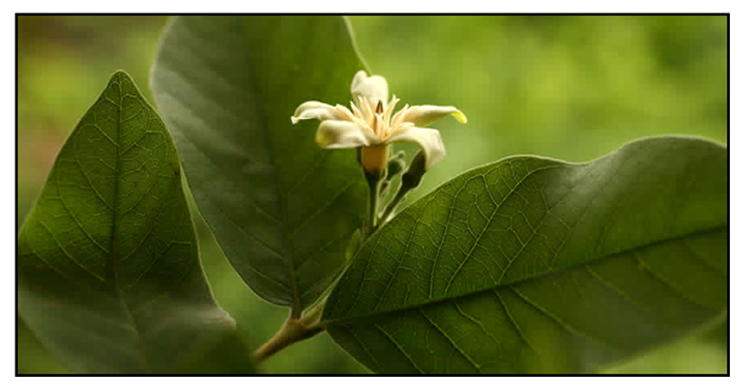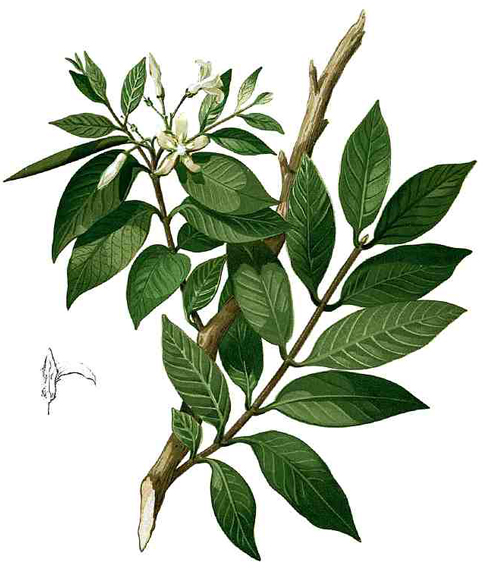 Botany Botany
Lanete is a tree growing to a height of 35 meters. Trunk is 60 centimeters in diameter. Bark is yellowish brown. Young branchlets are yellowish, pubescent, becoming glabrous with age, densely lenticellate. Petiole is about 1 centimeter. Leaf blade is narrowly oblong, ovate, or narrowly ovate, 5 to 10 by 3 to 6 centimeters, papery, puberulent to glabrous adaxially, with 8 to 15 pairs of veins. Cymes are about 5 centimeters, pubescent. Sepals are ovate, 2 to 5 millimeters. Corolla is white or pinkish white, funneiform; lobes are oblong, 1 to 2 centimeters; corona is fringed Stamens are pubescent, inserted at the mouth of the corolla; anthers are exserted. Follicles are connate, sublinear, 15 to 30 by 1 to 2 centimeters. Seeds are narrowly fusiform.
 Distribution Distribution
- In deciduous lowland thickets and forests.
- Also occurs in China, India, and Australia.
- Sometimes used for reforestation projects. (12)
Constituents
- Leaves yielded ursolic acid (1), oleanolic acid (2), squalene (3), ß-sitosterol (4) and chlorophyll a (5) from the leaves; and 1, 2, and amyrin acetate (6) from the twigs. (see studies below) (3)
- Study of dichlormethane extracts of leaves and twigs yielded
mixtures of ursolic acid (1) and oleanolic acid (2) (1:1 and 1:2); oleanolic acid (2), squalene (3), chlorophyll a (4), wrightiadione (5), and a-amyrin acetate. (see study below) (9)
- Study of dichlormethane extracts isolated ursolic acid (1), oelanolic acid (2), squalene (3), ß-sitosterol (4), and chlorophyll a (5) from leaves, and 1,2 and α-amyrin acetate from twigs. (10)
- Study of dichlormethane extract of twigs isolated an isoflavone, wrightiadione.
(11)
- Phytochemical screening yielded flavonoid, kuinon, polyphenol, saponin and triterpenoid, with absence of tannin and alkaloid.
Properties
- Studies have suggested anti-inflammatory and anti-nociceptive properties.
Parts used
Roots, bark, latex.
Uses
Edibility
- In Indonesia, bark used as coagulant in the manufacture of 'litsusu', a traditional cheese-like product. (12)
Folkloric
- Extracts from roots and barks used to treat scrofula and rheumatic arthralgia. Latex used for severe dysentery.
(3)
- An ingredient in Chinese medicines used for hiccups, arthritis, upper respiratory infections in children.
(3)
- Used by Malay people for toothache. (4)
- In Malaka, West Timor, leaves, roots and bark used for treatment of malaria.
(13)
Others
- Wood: Used for making furniture, poles, and musical instruments. (2)
- Paper: Bark fibers used for making paper and artificial cotton. (2)
Studies
• Chemical Constituents: Dichlormethane extracts yielded ursolic acid (1), oleanolic acid (2), squalene (3), ß-sitosterol (4) and chlorophyll a (5) from the leaves; and 1, 2, and amyrin acetate (6) from the twigs. (3)
• Anti-Inflammatory / Prostaglandin E2 Inhibition / Latex: Study of substances derived from Wrightia pubescens latex showed inhibitory activity on prostaglandin E2 (PGE2) production and cycloxygenase 2 (COX-2) expression in LPS-activated RAW 264.7 mouse macrophages which may play a role in the reduction of pain and inflammation. (5)
• Cytotoxicity against Cancer Cell Lines / Twigs and Leaves: Study of dichlormethane extracts of leaves and twigs yielded
mixtures of ursolic acid (1) and oleanolic acid (2) (1:1 and 1:2); oleanolic acid (2), squalene (3), chlorophyll a (4), wrightiadione (5), and a-amyrin acetate. The compounds were evaluated for antiprofiferative activities against three human cancer cell lines viz., breast (MCF-7), colon (HT-29 and HCT-116). Compounds 4, the two mixtures of 1 and 2, and compound 5 exhibited most cytotoxic effects against HT-29. Compound 2 showed moderate activity against MCF-7, and compound 6 showed highest cytotoxicity against HCT-116. (9)
• In Vitro Cytotoxicity: Study of evaluated the cytotoxic activity of crude extracts of three Philippine indigenous plants, Wrightia pubescens, Aphanamixis polystachys, and Platymitra arbores against selected human cancer cell lines using MTT assay. Cytotoxic activities of the extracts were found in the EA fractions of W. pubescens and P. arborea. All active fractions were highly cytotoxic to HCT116 and A549. (14)
Availability
Wild-crafted. |

![]()




 Distribution
Distribution